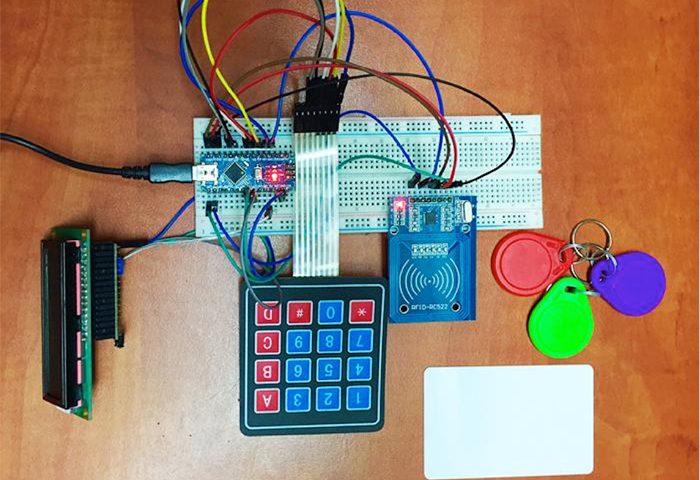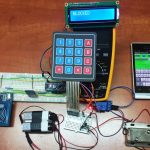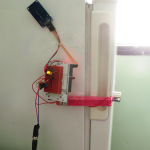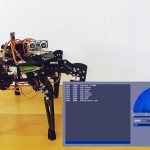自製Arduino RFID門鎖

已經煩透了丟失鑰匙或者忘記帶鑰匙而被鎖在門外嗎?好吧,讓我來為您提供一個完美的解決方案!今天,我們將製作一款Arduino RFID門鎖。我想要找到一種簡單並且安全的方法來鎖門,而不必購買一個昂貴的裝置。接下來,我們將要學習射頻識別(RFID)技術並將其應用到無線通訊中。
什麼是RFID?
“RFID表示射頻識別,[…]RFID的作用與信用卡或者ATM卡背面的條碼或磁條相同;它為物體提供了唯一的識別字。而且,就像必須掃描條碼或詞條才能獲取資訊一樣,RFID裝置必須經過掃描才能獲取相關的識別資訊。”摘自 ©Technovelgy,一個記錄科學技術與科幻創意的網站。
在本項目中透過使用RFID技術來從RFID標籤中讀取資料,並將資訊發送到MCU的非易失性記憶體。從標籤讀取的ID與存儲的資訊進行比較,如果匹配,則門將被解鎖/打開。
硬體
- Arduino Nano
- RFID RC522
- 壓電蜂鳴器
- 2x LED
- 2x 330 電阻
- 4×4 鍵盤
- LCD 合適器 I2C
- LCD16X2BL
軟體
- Arduino IDE
- SketchUp
- Github
將LCD 連接到Arduino
LCD有16個引腳,對於Arduino Nano來說引腳數量過多,因此一定要使用I2C合適器,如此一來可以僅透過Arduino的兩個訊號引腳來實現顯示功能。這很有説明,因為這種情況下需要透過MCU控制的引腳數量就會很少。

圖1:LCD引腳
LCD具有平行介面,這意味著MCU必須同時操控多個介面引腳來對顯示進行控制。下表提供了每個引腳的說明:

圖2:引腳規格
首先,我們將在LCD和I2C之間建立連接。為此,我們需要一個I2C LCD顯示卡(LCD1602)。該合適器將16 x 2字元LCD顯示轉換為序列I2C LCD,僅用兩根導線連接即可透過Arduino進行控制。

圖3:Arduino和LCD之間的連接
接下來,我們將在Arduino IDE中添加程式館“<LiquidCrystal_I2C.h>”。我們可以透過該程式館將LCD連接到Arduino。內建的LiquidCrystal_I2C程式館可以輕鬆實現在LCD螢幕上顯示字母。
您可以點擊此處下載LiquidCrystal_I2C.h。
請按照以下步驟將新的程式館安裝到您的Arduino IDE中:
1) 首先,從 Github 上下載檔案(我將要下載的是Keypad程式館)。

2) 壓縮(.zip)每個資料夾。

3) 拷貝.zip文件到您的Arduino資料夾中。

4) 打開Arduino並添加Keypad.zip::Sketch menu > Include Library > Add .ZIP Library。

5) 添加keypad程式館:Sketch menu > Include Library > Keypad。

測試LCD的代碼:
|
1 2 3 4 5 6 7 8 9 10 11 12 13 14 15 16 17 18 19 20 21 |
#include <Wire.h> #include <LiquidCrystal_I2C.h> LiquidCrystal_I2C lcd(0x27, 16, 2); // Set the LCD address to 0x27 for a 16 chars and 2 line display void setup() { lcd.begin();// initialize the LCD lcd.backlight();// Turn on the blacklight and print a message. lcd.backlight(); lcd.print("Hello, world!"); } void loop() { } |

圖4:連接到Arduino Nano的LCD
連接鍵盤
現在,要進入鍵盤部分了!我們將要對鍵盤進行連接,以實現在LCD上顯示從鍵盤輸入的數位。
Keypad.h 是一個讓Arduino能夠從鍵盤讀取矩陣類型鍵盤資料的程式館。
在本課程中我使用的是一個 4×4 鍵盤。
下表顯示了Arduino研發板與鍵盤之間的連接情況。鍵盤引腳連接到Arduino的數位輸出引腳。D6引腳是PWM引腳,因此用於蜂鳴器。
| Keypad pin | Arduino pin |
| 1 | D2 |
| 2 | D3 |
| 3 | D4 |
| 4 | D5 |
| 5 | A0 |
| 6 | D7 |
| 7 | D8 |

圖5:Arduino、LCD以及鍵盤之間的連接

圖6:連接到Arduino的LCD和鍵盤
連接RFID
接下來,我們將添加RFID。在這種情況下,RFID板使用SPI通信協議,其中Arduino將作為主機,而RFID閱讀器將作為從機。讀卡器和標籤將被設計為以13.56MHz大小的頻率進行通信。
這是很重要的一步,因為RFID會幫助我們從卡上讀取資料,並且確定ID是否對應於EEPROM中存儲的資訊。如果匹配,我們就能夠進入房間並顯示“解鎖”。否則,LCD將顯示“鎖定”。

圖7: Arduino、LCD以及RFID之間的連接

圖8: Arduino、LCD以及RFID
添加蜂鳴器以及LED
下一步是添加一個蜂鳴器和2個LED,以類比被控制訪問系統的狀況。請查看下面的接線圖(圖9)。我們設定了一個蜂鳴器,可以在獲得存取權限(解鎖)時蜂鳴。鎖定時,紅色LED始終亮起,解鎖時,綠色LED會亮起。
為了保護這些裝置模組,我決定用3D列印製造出收納的盒子。如果您沒有3D印表機,可以使用一個可以盛放所有元件的塑膠盒。這會很有説明,因為這樣一來這些模組將會被放置於內部,只有LED、鍵盤和LCD會放置在盒子外。

圖9:Nano、 LCD、鍵盤、RFID和蜂鳴器連接接線圖
製造收納的盒子
對於本專案,我想要製造一個自訂的盒子來收納所有的元件,並保護這些元件不被損壞。
我使用SketchUp設計了一個盒子,這個軟體具有使用者友好型介面,有一些簡單的操作按鈕,如橡皮擦、線條和卷尺工具等。
盒子的尺寸是 120x125x37 mm。

如果您對Sketchup不熟悉,建議您點擊此處閱讀一些Sketchup課程。

圖10:收納盒子(頂部視圖)

圖11:收納盒子(底部視圖)
設計盒子時,我考慮了以下尺寸:
- 頂部視圖:
- 2 個用於LED的開口 (5.2 mm)
- 1 個用於LCD的開口 (42.2×7.3 mm)
- 1 個用於線纜的開口(16×10.5 mm)
- 底部視圖:
- 1 個用於鍵盤的開口(27×10 mm)
在測量了元件的尺寸之後,我設計了一個非常緊湊的盒子。您可以根據自己的喜好對設計進行更改。

圖12:內部裝有模組的完整收納盒
代碼流程圖

完整代碼
|
1 2 3 4 5 6 7 8 9 10 11 12 13 14 15 16 17 18 19 20 21 22 23 24 25 26 27 28 29 30 31 32 33 34 35 36 37 38 39 40 41 42 43 44 45 46 47 48 49 50 51 52 53 54 55 56 57 58 59 60 61 62 63 64 65 66 67 68 69 70 71 72 73 74 75 76 77 78 79 80 81 82 83 84 85 86 87 88 89 90 91 92 93 94 95 96 97 98 99 100 101 102 103 104 105 106 107 108 109 110 111 112 113 114 115 116 117 118 119 120 121 122 123 124 125 126 127 128 129 130 131 132 133 134 135 136 137 138 139 140 141 142 143 144 145 146 147 148 149 150 151 152 153 154 155 156 157 158 159 160 161 162 163 164 165 166 167 168 169 170 171 172 173 174 175 176 177 178 179 180 181 182 183 184 185 186 187 188 189 190 191 192 193 194 195 196 197 198 199 200 201 202 203 204 205 206 207 208 209 210 211 212 213 214 215 216 217 218 219 220 221 222 223 224 225 226 227 228 229 230 231 232 233 234 235 236 237 238 239 240 241 242 243 244 245 246 247 248 249 250 251 252 253 254 255 256 257 258 259 260 261 262 263 264 265 266 267 268 269 270 271 272 273 274 275 276 277 278 279 280 281 282 283 284 285 286 287 288 289 290 291 292 293 294 295 296 297 298 299 300 301 302 303 304 305 306 307 308 309 310 311 312 313 314 315 316 317 318 319 320 321 322 323 324 325 326 327 328 329 330 331 332 333 334 335 336 337 338 339 340 341 342 343 344 345 346 347 348 349 350 351 352 353 354 355 356 357 358 359 360 361 362 363 364 365 366 367 368 369 370 371 372 373 374 375 376 377 378 379 380 381 382 383 384 385 386 387 388 389 390 391 392 393 394 395 396 397 398 399 400 401 402 403 404 405 406 407 408 409 410 411 412 413 414 415 416 417 418 419 420 421 422 423 424 425 426 427 428 429 430 431 432 433 434 435 436 437 438 439 440 441 442 443 444 445 446 447 448 449 450 451 452 453 454 455 456 457 458 459 460 461 462 463 464 465 466 467 468 469 470 471 472 473 474 475 476 477 478 479 480 481 482 483 484 485 486 487 488 489 490 491 492 493 494 495 496 497 498 499 500 501 502 503 504 505 506 507 508 509 510 511 512 513 514 515 516 517 518 519 520 521 522 523 524 525 526 527 528 529 530 531 |
#include <SPI.h> #include <MFRC522.h> #include <Wire.h> #include <LiquidCrystal_I2C.h> #include <Keypad.h> #include<EEPROM.h> int relPin; int state=0; byte COD[10]; byte AUX[10]; int k=0; String accessCode="*123456#"; String codpairing="*654321#"; //NFC #define RST_PIN 9 #define SS_PIN 10 MFRC522 mfrc522(SS_PIN, RST_PIN); // Create MFRC522 instance #define NEW_UID {0xDE, 0xAD, 0xBE, 0xEF} MFRC522::MIFARE_Key key; //LCD LiquidCrystal_I2C lcd(0x27,16,2); //KEYPAD const byte numRows= 4; //number of rows on the keypad const byte numCols= 4; //number of columns on the keypad char keymap[numRows][numCols]= { {'1', '2', '3', 'A'}, {'4', '5', '6', 'B'}, {'7', '8', '9', 'C'}, {'*', '0', '#', 'D'} }; //Code that shows the the keypad connections to the arduino terminals byte rowPins[numRows] = {2,3,4,5}; //Rows 0 to 3 byte colPins[numCols]= {A0,7,8,9}; //Columns 0 to 3 //initializes an instance of the Keypad class Keypad myKeypad= Keypad(makeKeymap(keymap), rowPins, colPins, numRows, numCols); void setup() { pinMode(A0,OUTPUT); digitalWrite(A0,HIGH); pinMode(A3,OUTPUT); digitalWrite(A3,HIGH); pinMode(A1,OUTPUT); digitalWrite(A1,HIGH); pinMode(A2,OUTPUT); digitalWrite(A2,LOW); //NFC Serial.begin(9600); // Initialize serial communications with the PC while (!Serial); // Do nothing if no serial port is opened SPI.begin(); // Init SPI bus mfrc522.PCD_Init(); // Init MFRC522 card for (byte i = 0; i < 6; i++) { key.keyByte[i] = 0xFF; } lcd.begin(); lcd.backlight(); lcd.setCursor(0,0); lcd.clear(); lcd.print( "BLOCKED" ); } void readNFC(){ // This function will read the code stored on for (byte i =0; i<(mfrc522.uid.size); i++) { // the UID COD[i]=mfrc522.uid.uidByte[i]; } Serial.print("COD"); Serial.print(COD[0]); Serial.print(COD[1]); Serial.print(COD[2]); Serial.print(COD[3]); } void pairNFC(){ Serial.println("COD in pair"); Serial.print(COD[0]); Serial.print(COD[1]); Serial.print(COD[2]); Serial.print(COD[3]); long r=0; int c=0; for(int i=1;i<=EEPROM.read(0);i++){ //The UID cannot be stored on switch(i%4){ // one variable, it was needed to be case 1 :{AUX[0]=EEPROM.read(i); break;} // split case 2 :{AUX[1]=EEPROM.read(i); break;} case 3 :{AUX[2]=EEPROM.read(i); break;} case 0 :{AUX[3]=EEPROM.read(i); break;} } if((i)%4==0) {Serial.println(r); if( AUX[0]==COD[0] && AUX[1]==COD[1] && AUX[2]==COD[2] && AUX[3]==COD[3] ){ //Verify if the code is in EEPROM lcd.clear(); lcd.setCursor(0,0); lcd.print("CODE ALREADY IN"); lcd.setCursor(0,1); lcd.print("SYSTEM"); delay(2000); c=1; break;} } } if(c==0){int aux2=EEPROM.read(0); Serial.println("CODE PAIRED"); Serial.print(COD[0]); Serial.print(COD[1]); Serial.print(COD[2]); Serial.print(COD[3]); EEPROM.write(aux2+1,COD[0]); //Writing code in EEPROM EEPROM.write(aux2+2,COD[1]); EEPROM.write(aux2+3,COD[2]); EEPROM.write(aux2+4,COD[3]); aux2=aux2+4; // Position for a new code Serial.println("aux2"); Serial.println(aux2); EEPROM.write(0,0); EEPROM.write(0,aux2); lcd.clear(); lcd.setCursor(0,0); lcd.print("CODE PAIRED"); delay(2000);} } boolean validationNFC(){ boolean c=false; for(int i=1;i<=EEPROM.read(0);i++){ //Read the EEPROM switch(i%4){ case 1 :{AUX[0]=EEPROM.read(i); break;} case 2 :{AUX[1]=EEPROM.read(i); break;} case 3 :{AUX[2]=EEPROM.read(i); break;} case 0 :{AUX[3]=EEPROM.read(i); break;} } if((i)%4==0) { if( AUX[0]==COD[0] && AUX[1]==COD[1] && AUX[2]==COD[2] && AUX[3]==COD[3]) c=true; //Verify if the code is in EEPROM and make flag=true; } } return c; } int compareCODE(String a) //We type a code on keypad and this will be compared { //with the accessCode; if(a.equals(accessCode)) return 1; else if(a.equals(codpairing)) return 2; else return 0; } String takeCode(char x) //Will display on the LCD the code typed { char vec[10]; vec[0]=x; lcd.setCursor(0,0); lcd.clear(); lcd.print('X'); for(int i=1;i<8;i++) {vec[i]=myKeypad.waitForKey(); //Waits for 8 keys to be pressed and after that lcd.print('X');} //is taking the decision vec[8]=NULL; String str(vec); return str; } void loop() { switch(state){ case 0: { mfrc522.PCD_Init(); if ( mfrc522.PICC_IsNewCardPresent() && mfrc522.PICC_ReadCardSerial() ){ readNFC(); //It will read the card and it will search for UID in its if(validationNFC()) //memory { state=1; lcd.clear(); lcd.setCursor(0,0); lcd.print( "VALID NFC CODE" ); //The door will be opened delay(1000); return; } else{ lcd.clear(); lcd.setCursor(0,0); lcd.print( "INVALID NFC CODE" ) //If the code was wrongblocked delay(1000); lcd.setCursor(0,0); lcd.clear(); lcd.print( "BLOCKED" ); return; } } char c=myKeypad.getKey(); if(c != NO_KEY){ String codcurent=takeCode(c); int A=compareCODE(codcurent); if(A==0){ //A is a variable that stores the current code lcd.clear(); lcd.print("INVALID CODE"); delay(2000); lcd.setCursor(0,0); lcd.clear(); lcd.print("BLOCKED"); return; } if(A==1){ lcd.setCursor(0,0); lcd.clear(); lcd.print( "VALID CODE " ); delay(2000); state = 1; Return; } if(A==2); { state=2; lcd.clear(); lcd.setCursor(0,0); lcd.print( " Pairing..." ); delay(2000); return;} } break; } case 1:{ lcd.clear(); lcd.setCursor(0,0); lcd.print( "UNLOCKED" ); digitalWrite(A3,LOW); digitalWrite(A1,LOW); //The red LED will be off digitalWrite(A2,HIGH); //The green LED will be on tone(6,3000,5010); //The buzzer will make a sound delay(5000); //After 5 seconds the system will be blocked digitalWrite(A3,HIGH); digitalWrite(A1,HIGH); digitalWrite(A2,LOW); state=0; lcd.setCursor(0,0); lcd.clear(); lcd.print( "BLOCKED" ); return; } case 2:{ mfrc522.PCD_Init(); if ( mfrc522.PICC_IsNewCardPresent() && mfrc522.PICC_ReadCardSerial() ){ readNFC(); pairNFC(); state=0; delay(2000); lcd.clear(); lcd.setCursor(0,0); lcd.print( "BLOCKED" ); } break; } } } |
結論
至此,我們成功製作了一款低成本的Arduino RFID門鎖。對我來說,這是一個很有趣的項目,因為我是為自己使用而製作的。此外,製作一個這樣的裝置不僅能讓您因為做了一些有用的事而產生滿足感,學習到很多知識,還能讓您對自製電子裝置有初步的嘗試和體驗。與各種各樣的研發板打交道是非常具有挑戰性的。本專案還包含了很多有趣的課題,例如:
- 與其他Arduino程式館一起使用
- 理解EEPROM的使用
- 使用多種通信,如I2C, SPI
點擊此處閱讀本文的第二部分,我們將研發用智慧手機端解鎖的功能!查看我們的Arduino 項目,瞭解其他有趣且具有挑戰性的Arduino項目!









